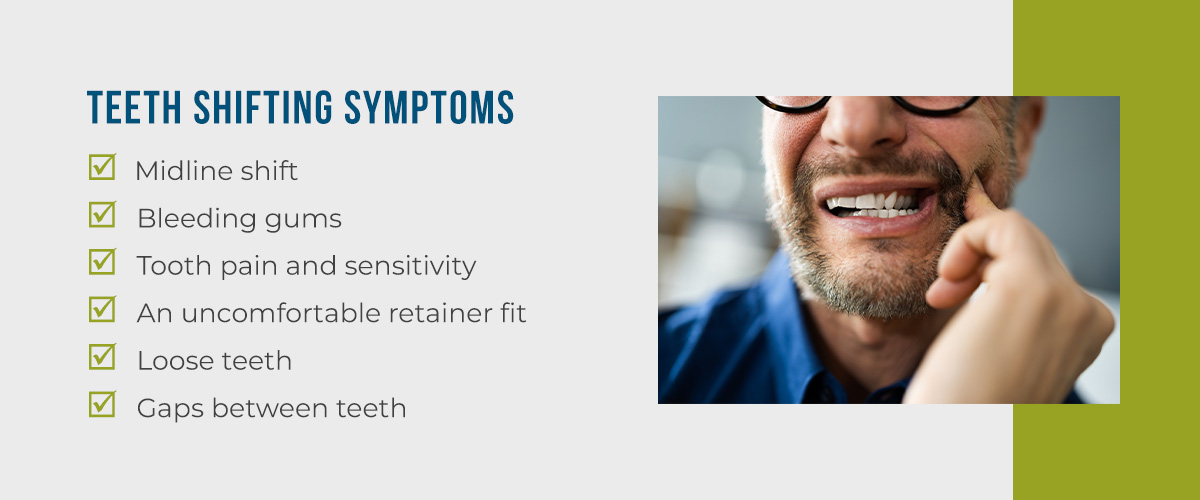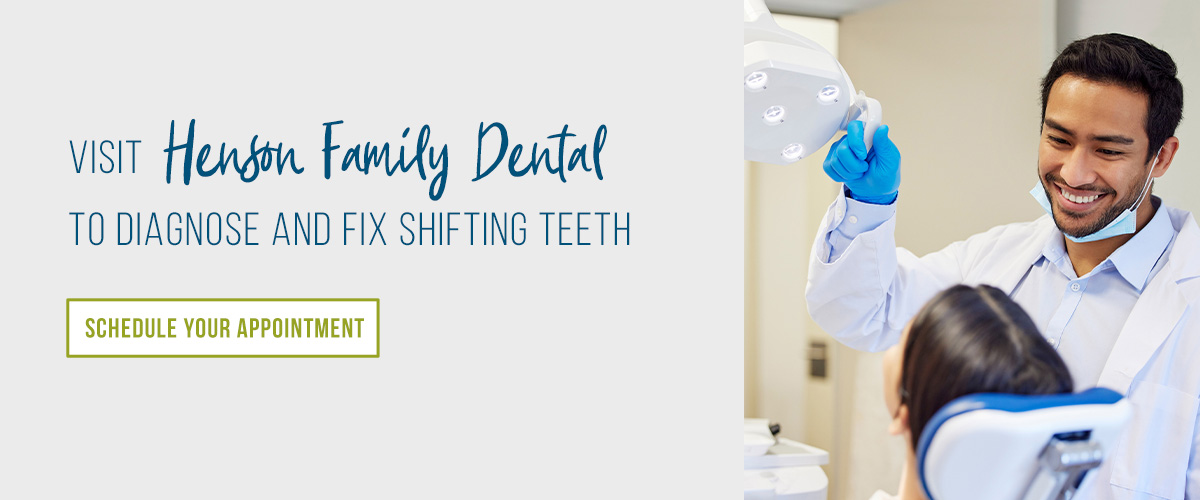Signs Your Teeth Are Shifting
May 16, 2024 8:46 am
While most of us would assume that permanent teeth are immovable and completely fixed in place unless a traumatic injury were to dislodge them, this isn’t entirely true. Our teeth have some flexibility and room to move. Rather than being fixed directly to the upper and lower jawbones, teeth are connected by periodontal ligaments and cementum material. This connective tissue is similar to bone, although it is softer. Gum tissue encases and protects the ligaments and the tooth.
Because teeth are not completely fixed, they can shift for various reasons. However, when teeth shifting occurs, the process is gradual. It’s unlikely that you’ll wake up one morning to notice your teeth have shifted from their original position.
So, what are the signs of shifting teeth? Keep reading to learn the causes, symptoms and treatment options for shifting teeth.
5 Common Causes of Teeth Shifting
Teeth can shift for various reasons. In some cases, teeth can shift as we age. In others, oral health conditions can play a role. Here are some of the more common causes of teeth shifting.
1. Natural Aging
As we age, our bodies change in various ways. But beyond wrinkles and fine lines, the natural aging process can prompt a decrease in bone density. As bone density loss affects teeth and jawbones, teeth can begin to shift. Moreover, teeth endure more wear and tear as we age, which can eventually affect alignment and cause shifting. Decades of wear and tear will also degrade enamel, leaving teeth more prone to damage and decay.
Saliva production also decreases with age. Lower saliva production can lead to dry mouth, known as xerostomia, which can cause gums to thin and recede. When gum lines recede, teeth can become loose and start shifting as a result.
2. Bone Density Changes
Aside from the natural aging process, various other factors can prompt bone density changes. Bone density refers to the volume of bone calcium and other essential minerals within bone tissue.
Mineral deficiencies and hormone production problems can cause bone density changes that can impact the jaw. A loss of bone density can influence jaw stability and structure, leading to loose, shifting teeth.
3. Periodontal Disease
More commonly known as gum disease, periodontal disease is a severe gum infection. Gum disease eats away the soft, protective gum tissue surrounding the teeth and can eventually degrade the bone that supports the teeth, the dental alveolus or the tooth socket. When gum disease progresses to destroy this tissue, teeth can become loose and start to shift. Untreated gum disease can lead to tooth loss.
4. Teeth Grinding
Bruxism is a condition that causes jaw clenching and teeth grinding. Those with this condition will grind and gnash their teeth while asleep or when awake. While sleep bruxism is a sleep-related disorder that is often linked to other sleep disorders like sleep apnea, conscious bruxism can stem from stress, anxiety and tension. Both types of bruxism can lead to jaw disorders, headaches and tooth damage.
Grinding teeth can wear down enamel, causing teeth to become flatter and looser. While this condition can cause teeth to loose, the excessive pressure from grinding and gnashing can even cause painful tooth fractures.
5. Tooth Loss
While various factors can lead to tooth loss, such as gum disease, aging and teeth grinding, as mentioned above, impact injuries can also cause tooth loss. Regardless of the cause, a missing tooth leaves a gap in the gum line. Without a placeholder, surrounding teeth will start to shift to fill the empty space.
Teeth Shifting Symptoms
It can be quite difficult to know for sure if your teeth are shifting out of place. Because the phenomenon happens so gradually, you’re unlikely to notice the shift. However, you may notice these common indicators of tooth shifting:

- Midline shift: The line between your two front teeth and lower teeth is known as the midline. When teeth shifting occurs, the midline becomes misaligned. You may notice the line between your lower teeth does not lead up to the line between your two front teeth.
- Bleeding gums: A common symptom of gum disease and teeth grinding is bleeding gums. When bruxism or gum disease is an underlying issue, you may experience bleeding gums. You might notice your gums are bleeding when brushing your teeth or you might taste blood in your mouth throughout the day.
- Tooth pain and sensitivity: Shifting teeth can cause pain and discomfort accompanying tooth sensitivity. These symptoms are also associated with gum disease.
- An uncomfortable retainer fit: If you use a retainer and notice it no longer fits comfortably, it may be a sign that your teeth are shifting out of place and no longer align with your retainer’s sizes and shape.
- Loose teeth: If you press your tongue against your teeth and they seem a bit wiggly, your teeth might be shifting.
- Gaps between teeth: One of the definite signs of teeth shifting is gaps between the teeth.
While tooth pain and sensitivity can be warning signs that your teeth are moving, it is a gradual process that does not cause sudden pain. Moreover, pain levels associated with shifting teeth are generally mild.
How to Prevent Teeth From Shifting
While minor teeth shifting can be an age-related effect, prominent shifting can have negative impacts on your health. Aside from the discomfort of the symptoms listed above, shifting teeth can increase the risk of developing gum disease, tooth decay and tooth loss. Fortunately, there are some prevention measures that can help.
Regular dental checkups enable your dentist to monitor your overall oral health. If your teeth are shifting, your dentist will be able to identify the phenomenon early on, which makes intervention possible.
Lifestyle changes can also serve as a prevention tactic. Certain habits, like nail biting and chewing hard objects, can cause teeth shifting, so it’s wise to try to kick these kinds of habits. Diet and nutrition also play a key role in dental and oral health. Adopting a healthy diet can improve oral health. Regularly brushing with a soft-bristle toothbrush and flossing routinely can also help maintain oral health.
How to Fix Teeth That Have Shifted
Unfortunately, some of the factors that lead to teeth shifting are unpreventable, like age. However, there are treatment options available that can help you manage your oral health, regardless of the underlying cause.
- Braces: Traditional braces and Invisalign clear braces can help align teeth and prevent further shifting. Henson Family Dental can help you choose the right braces for your needs.
- Treat bruxism symptoms: If teeth grinding is a concern, visit your health care practitioner to identify the root cause. Whether bruxism is related to a sleep disorder or high stress levels, seeking treatment can help you prevent dental damage. At Henson Family Dental, we also offer nightguards and mouthguards that can help prevent teeth grinding.
- Treat gum disease: Gum disease is a treatable infection. If your teeth are shifting as a result of gum disease, schedule a professional cleaning at Henson Family Dental and we’ll treat the infection to provide relief.
- Wear a retainer: Retainers can help keep your teeth aligned. A custom-fit retainer can also help you avoid needing dental braces in the future. We can assist with a comfortable, well-fitting retainer.
Visit Henson Family Dental to Diagnose and Fix Shifting Teeth
Whether you’ve noticed gaps in your teeth or you’re concerned about bleeding gums and other oral health symptoms, schedule an appointment at Henson Family Dental. Our expert dentists can diagnose and fix shifting teeth.
Contact us online or call 813-981-1259 to schedule an appointment.

